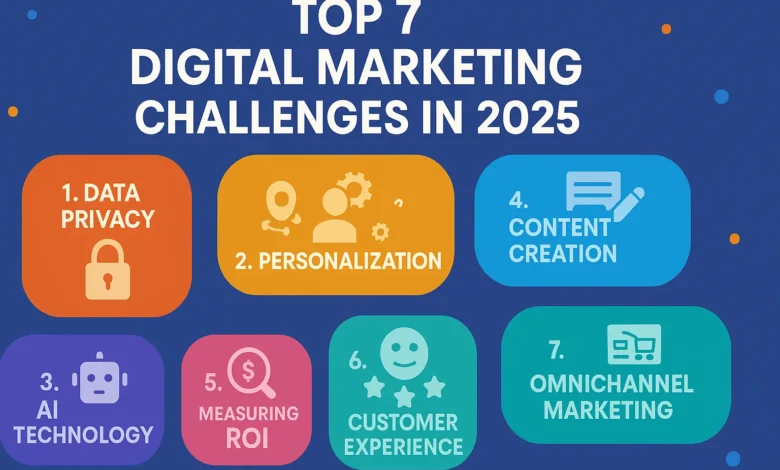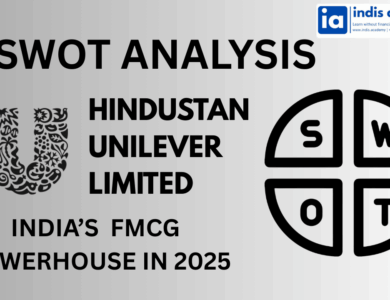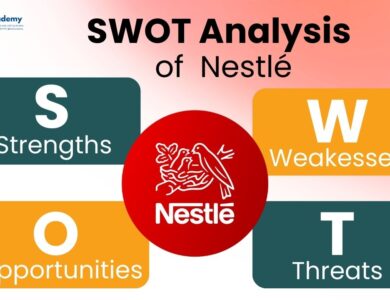Top 7 Digital Marketing Challenges in 2025: How to Overcome Competition and Ad Fatigue
"Discover the top 7 digital marketing challenges of 2025, including ad fatigue and rising competition, and learn effective strategies to overcome them."

Ever feel like your marketing efforts aren’t working like they used to?
Your ads are live, your content is consistent, but the results? Slowing down. You’re not alone. In 2025, digital marketers are facing more pressure than ever—from rising competition to audiences that just don’t care anymore.
Why? Because the digital space is crowded, consumers are overwhelmed, and platforms are changing the rules faster than we can keep up.
One of the biggest hurdles today? Ad fatigue—your audience is tired of seeing the same type of content over and over again. Combine that with aggressive competition in every niche, and you’ve got a serious marketing challenge on your hands.
But here’s the good news: These problems can be solved.
In this guide, we’ll break down the 7 most common digital marketing challenges in 2025 and show you how to tackle them with smart, practical strategies that actually work.
Let’s get into it.
Learn AI & Digital Marketing,
Pay Fees After Placement
- ✅ Minimal Admission Fees
- ✅ No Loan or Income Sharing Agreement
- ✅ 100% Placement Support
- ✅ ISO & Govt Registered Certificate
- ✅ Practical 3+1 Months Duration
Get a free counseling call. We’ll guide you through learning, certification, and job placement.
Request a Free Call Back
Takes less than a minute.
Challenge #1: Ad Fatigue Is Killing Conversions
Let’s face it—we’re all tired of seeing the same ads. And so is your audience.
Ad fatigue happens when people see your ads so many times that they start ignoring them completely. Your once high-performing campaign suddenly drops in engagement, CTR, and conversions. Sound familiar?
With users spending hours on social media, algorithms constantly recycle your ad creatives. What starts as a scroll-stopper soon becomes just another background image. And the more platforms you use the same creative on, the faster it dies out.
Also Read: Lakmé SWOT Breakdown: How the Brand Rules India’s Beauty Market
Signs of Ad Fatigue:
- Drop in click-through rates (CTR)
- Higher cost-per-click (CPC)
- Less engagement or completely ignored content
- Negative feedback or increased “hide ad” actions
How to Beat It:
1. Refresh Creatives Regularly
Change your visuals, headlines, and CTAs every 1–2 weeks for active campaigns.
2. Use Dynamic Creative Optimization (DCO)
Let platforms auto-test combinations of images, text, and formats to keep content fresh without manual effort.
3. Segment and Rotate Audiences
Instead of blasting one message to all, break audiences into smaller groups and rotate creatives based on behavior and interests.
4. Incorporate UGC (User-Generated Content)
Real faces, real experiences—people trust people more than polished ads. Use testimonials, reviews, and short clips from actual users.
5. Experiment with Formats
Switch things up. If you’re always running static images, try carousels, reels, or interactive polls.
Ad fatigue isn’t a failure—it’s a signal. A sign that your audience wants something new. So listen, adapt, and test creatively.
Also Read: Complete SWOT Analysis of Jio – A Deep Dive into India’s Telecom Disruptor
Challenge #2: Extreme Competition in Every Niche
No matter what niche you’re in—fitness, finance, fashion, or even farming—it feels like everyone is doing digital marketing.
From solopreneurs to big brands and now AI-generated content flooding the internet, the space is more crowded than ever. Costs are rising, attention spans are shrinking, and standing out feels like trying to shout in a stadium full of screaming marketers.
Let’s be honest—it’s tough. But it’s not impossible.
The Reality:
- Cost-per-click (CPC) is higher than ever
- Algorithms favor bigger brands or bigger budgets
- Customers are overwhelmed with choices
- AI tools make it easy to produce content, but harder to stand out
How to Beat the Competition:
1. Find a Micro-Niche and Own It
Instead of trying to speak to everyone, speak to a specific tribe.
Example: Don’t just target “fitness” → go for “fitness for new moms with no time.”
2. Build Authority Through Storytelling
People trust humans, not just headlines. Share your journey, values, and behind-the-scenes. Your story is your edge.
3. Use Long-Tail Keywords
Instead of ranking for “digital marketing,” try “digital marketing tips for solo founders in India.”
Less competition, more relevance.
4. Explore Less Saturated Channels
If everyone’s on Instagram, test Pinterest, LinkedIn, Reddit, or podcasts. Sometimes, being early somewhere else is better than being late where it’s crowded.
5. Go Deep, Not Just Wide
Publish high-quality, comprehensive content that solves real problems. Become the go-to source for your topic, not just another voice.
Competing in digital marketing today isn’t about being the loudest—it’s about being the most useful, most trusted, and most memorable.
Challenge #3: Declining Organic Reach
Remember the days when your posts would reach most of your followers? Those days are gone.
In 2025, platforms like Instagram, Facebook, and even LinkedIn are throttling organic reach. Your content might be great, but only a fraction of your audience is seeing it. Why? Because platforms want you to pay for visibility.
Even SEO is more competitive now—with AI summaries taking up space in Google’s results and fewer clicks going to organic listings.
What This Means:
-
Fewer likes, comments, and shares—even on good content
-
Organic traffic from social and search continues to shrink
-
Harder to grow without ads or unique strategy
How to Fight Back:
1. Repurpose High-Performing Content
Turn blog posts into carousels, tweets into reels, or case studies into YouTube Shorts. One idea = multiple formats = more reach.
2. Build SEO Topic Clusters
Instead of random blog posts, create clusters around one core topic. Link them internally to help Google understand your content better.
3. Focus on Engagement Signals
Algorithms reward content that sparks conversations. Ask questions, use polls, respond to every comment, and encourage shares/saves.
4. Diversify Traffic Sources
Don’t depend on one platform. Build your email list, get active in communities, and explore podcast guesting or collaborations.
You can’t control the algorithm—but you can control how helpful and engaging your content is. That’s how you stay visible when organic reach drops.
Challenge #4: Consumer Attention Span Is Shrinking
Here’s the harsh truth—you have less than 8 seconds to grab someone’s attention. That’s shorter than a goldfish.
With endless scrolls, pop-ups, and notifications competing for eyeballs, your content has to work harder—and faster—to make an impact.
Even if your message is powerful, if the first 3 seconds don’t hook the viewer, they’ll swipe away without thinking twice.
The Problem:
- Users are overwhelmed and distracted
- Long intros or slow-loading content = instant drop-off
- Even ads with solid offers get ignored if the first frame flops
How to Hold Their Attention:
1. Lead with the Hook
Whether it’s a reel, blog, or email—start with a bold statement, stat, or question that speaks directly to the user’s pain or curiosity.
2. Use Short-Form Video
Reels, Shorts, and TikToks are dominating right now. Keep it snappy, visual, and value-packed within 15–30 seconds.
3. Make Content Interactive
Use polls, sliders, quizzes, or “tap to reveal” carousels. If they’re clicking, they’re staying.
4. Break Text Visually
In blogs, use short paragraphs, bullet points, emojis, subheadings, and bold lines to make content scannable.
5. Test Different Formats
Everyone learns differently. Try mixing in audio snippets, infographics, memes, or bite-sized tutorials.
Attention is the new currency in marketing—and if you earn it fast, you can turn it into trust, engagement, and sales.
Also Read: Complete SWOT Analysis of Hyundai – A Deep Dive into the Korean Auto Giant
Challenge #5: Content Overload & Same-ness
Let’s be real—most content looks and feels the same.
Same templates. Same “5 tips” listicles. Same Canva designs.
And with AI tools churning out thousands of blogs and posts daily, the digital space is drowning in generic content.
As a result, your audience is becoming numb. They scroll past polished graphics and copy-pasted captions because it all feels… predictable.
The Problem:
- AI content = faster, but often less emotional
- Everyone is chasing trends, not originality
- Audiences are craving realness, not perfection
How to Cut Through the Noise:
1. Tell Stories, Not Just Tips
Share customer journeys, behind-the-scenes moments, or personal struggles.
Real stories create real connections.
2. Personalize With Data
Use what you know—location, behavior, preferences—to deliver content that actually feels relevant.
3. Mix Up Your Visuals
Ditch the stock photos. Try illustrations, doodles, memes, or your own voice-over videos.
Even low-fi, authentic visuals perform better than “perfect” but lifeless ones.
4. Add Your Unique POV
AI can’t replicate your tone, experience, or insight. Share your opinion. Take a stand. Add flavor.
That’s what keeps people reading.
5. Include Your Audience in Content Creation
Let your followers contribute. Run contests, ask for feedback, or feature their testimonials.
It’s more engaging and builds community.
You don’t need to create more content—you need to create content that feels different.
Challenge #6: Tracking & Privacy Barriers
Digital marketing used to be all about data. But in 2025, tracking user behavior is tougher than ever.
Thanks to iOS privacy updates, third-party cookie restrictions, GDPR rules, and the shift to GA4—marketers are flying blind more often than they’d like.
You can’t retarget users the same way. You can’t easily attribute which ad led to which sale. And you definitely can’t rely on the same tracking tricks from 2020.
The Problem:
-
Pixel-based retargeting isn’t what it used to be
-
GA4’s learning curve is steep for many marketers
-
Users are opting out of tracking more than ever
Smart Solutions:
1. Shift to First-Party Data
Focus on collecting data directly from your audience—via email signups, quizzes, and gated content. Own your list, don’t rent it.
2. Use UTM Parameters Everywhere
Want to know which link or ad drove results? Add UTM tags to every campaign. It gives clean, simple tracking without relying on cookies.
3. Learn GA4 (and Set It Up Properly)
It’s not optional anymore. Use custom events and goals in GA4 to track the stuff that matters—conversions, not just clicks.
4. Build Communities, Not Just Campaigns
Instead of chasing cold leads, create owned communities via WhatsApp, Telegram, Discord, or private groups.
You don’t need to “track” users when they’re already choosing to stay close.
5. Respect Privacy, Build Trust
Be upfront about what you collect and why. Offer value in return. Brands that respect privacy will be the ones customers stick with long term.
Challenge #7: Scaling Without Losing Quality
Growth is exciting—until it starts breaking things.
You’re posting more, launching more campaigns, onboarding new clients… and suddenly, the quality drops. Graphics feel rushed, replies are delayed, and your once-personal content feels robotic.
This is the cost of scaling without systems.
Common Issues:
-
Inconsistent brand voice or visuals
-
Burned-out team members or solo marketers
-
Missed deadlines and sloppy execution
-
Quality control becomes reactive, not proactive
How to Scale the Right Way:
1. Build SOPs (Standard Operating Procedures)
Document how you do things—ad setup, content creation, email flows, everything.
It makes it easier to train others and maintain consistency.
2. Automate Repetitive Tasks
Use tools to schedule posts, send emails, generate reports, or auto-respond to FAQs.
Free up your time for the creative stuff.
3. Outsource Strategically
You don’t have to do everything in-house. Hire freelancers for content, design, or ads—but only with clear briefs and review steps.
4. Use Project Management Tools
Trello, Notion, ClickUp—pick one. Use it to track tasks, set timelines, and avoid the chaos of “who’s doing what?”
5. Protect Your Brand Voice
Create a tone and style guide. Whether it’s you or someone else writing—it should still sound like your brand.
Scaling is exciting—but if you want long-term growth, don’t just think bigger. Think better.
Conclusion
Digital marketing in 2025 isn’t getting easier—it’s getting smarter.
Yes, you’re battling ad fatigue. Yes, competition is brutal. And yes, the rules keep changing. But here’s the good news: these challenges are not roadblocks—they’re reminders.
Reminders to evolve. To focus on value. To stop copying and start connecting.
We’ve covered 7 real challenges:
- Ad fatigue draining conversions
- Overwhelming competition in every niche
- Falling organic reach
- Shrinking attention spans
- Content sameness
- Tracking headaches
- Scaling without chaos
But each of these problems comes with practical solutions—if you’re willing to test, adapt, and lead with creativity.
So ask yourself: Are you just running ads… or creating experiences?
Are you chasing clicks… or building communities?
Are you overwhelmed… or leveling up?
Because digital marketing isn’t dying. It’s just becoming more human.
And in this crowded, fast-moving digital world, the most human brand wins.





